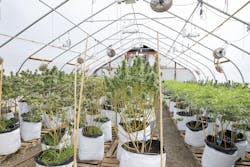Note: In conjunction with SecurityInfoWatch.com and Security Technology Executive magazine, we invite you to participate in the SecuraCann Conference, the industry’s only security exclusive event. Designed to inform commercial growers, dispensary retailers, investors and integrators of innovative technology and solutions to mitigate risk and secure their cannabis operations. This virtual event will take place on October 14-15 will offer a focused look at security and risk issues and solutions, providing an opportunity for an educated decision-making process related to technology, policy and procedure, operations and more.
When Canada passed legislation for the legalization of cannabis for adults in 2018, it was no surprise to many of the security professionals across the country who had been gearing up for the launch. Although the new law caused havoc with its international drug treaties, Canadians were already beyond the point of no return having set up a strict framework of compliance, regulations, extensive public education and proactive monitoring and surveillance programs in preparation for legalization.
In fact, the overarching approach to legal cannabis legislation has been so successful that in a presentation to the United Nations’ Commission on Narcotic Drugs this past March – two years after legalization – the director-general for Health Canada reported that the illegal cannabis market in the country lost 30% of its market share, which represented nearly $2 billion in sales ripped from the hands of criminal organizations. With Canada becoming the first industrialized western country to allow recreational use, the pressure on the United States to follow suit on a federal level is growing. Canada’s legalization and normalization of its robust cannabis industry and the expanding acceptance across the U.S. has one constant that permeates an inevitable marriage of North America’s two largest cannabis nations – compliance and strict physical and cybersecurity.
Take an Enterprise Security Approach to Cannabis Operations
Cannabis industry management consultant Michael Elkin has ridden the cannabis tsunami for almost a decade from one end of Canada to the other and parts of the U.S. as a security consultant, compliance and licensing expert, a systems integrator, a marketing director, to his current gig with his own company called CannaBrokr where he does private consulting for established grow operations, established dispensaries and retailers. Elkin also helps emerging applicants and license holders get into the cannabis game from a cultivation perspective.
But he cut his teeth in the security industry with Marcomm Systems Group out of Ottawa as it was becoming a player in enterprise-level cannabis security systems design. He and his group installed approximately 45 systems for grow operations around Canada for the three years he was there.
“These were all enterprise solutions. I think the smallest affiliate might have been, 15,000 or 20,000 square feet, and the biggest was over a million square feet. All these projects were fully integrated systems that showcased huge video surveillance setups, with some requiring something like two years of video storage,” says Elkin, who firmly believes that it was the Canadian government’s emphasis on strong security infrastructure across the fledgling cannabis industry that has created its robust economic engine.
It is surveillance and monitoring that Elkin recommends grow ops invest in from the outset, stressing that building out the rest of the security framework with advanced video as the foundation is a formula that works.
“There were cameras in every grow op. Everywhere there was cannabis present we had digital video cameras. There was also surveillance set up beyond on-site video sources that required us to build out petabyte servers to be able to store all that video,” Elkin says pointing out that the importance of video surveillance and the subsequent analytics dictated it is the platform for the integrated solution. “Most grow ops we did also had advanced access control systems using biometric card readers and dual-authentication card readers. Security levels called for card readers on both sides of the doors.”
Elkin marveled at how Marcomm took its expertise in designing prisons and hospitals and transferred that knowledge to cannabis facilities. He points out that many of the grow ops his company designed were much like prisons and hospitals. However, unlike the Canadian correctional agencies that wanted to keep inmates in, Health Canada wanted to keep people out of grow operation facilities.
“We used the same design concepts as the prisons and hospitals since we had no other examples to work from. You needed a 10-foot chain-link fence with sensors and fence controls on the gates. And then we opted for automated system turnstiles in many of these facilities. The designs were highly integrated system, from front to back,” Elkin says.
How to Assess Some Best Practices
Unlike working in Canada, Elkin’s experience in the U.S. is different simply based on the various state-to-state regulations instead of a federalized and unified security and compliance approach. While this makes for nuanced differences, he admits that grow facilities in the U.S. face the same threats and challenges as those across the northern border.
As with any project, the project manager and systems integrator must have a thorough understanding of the client and the facility. Beginning with a comprehensive risk assessment, the client will convey their vision of the facility’s flow and the project team will create their technology and solutions flowchart. Elkin says that the project team must work with the client to establish a personnel flow that prioritizes the access levels of all facility staff, from the master grower to the quality assurance person, from the trimmers and cultivators to the packaging workers.
“As a security integrator and project manager, I also need to understand the regulations of the state, country, or place that the facility is going to be established. What are the permissions and what are the rules and responsibilities of each person that are going to be in the facility? That allows us to map out where certain people are going to be on a day-to-day basis and what areas of the facility, they will have access to,” explains Elkin. “We want to know that there's going to be controlled in not only managing traffic flow in and around the hallways and open work and grow spaces, but we want to ensure that control will also be monitored by video surveillance so we can secure highly concentrated traffic areas and avoid blind spots in the facility by knowing where the optimum camera placement is.”
Since Elkin is a proponent of building security from the video system on out, taking the initial steps to properly select and place video cameras is crucial. He asserts that the integrator and project team must understand the types of vegetation that will be harvested in the facility, realizing that some facilities will have cannabis strains that grow differently.
“You could walk into a facility that's going to be a clone room or vegetation room, and if you pop a camera onto a wall without knowing that this will be a full flowering room where you're going to have plants that are positioned on tables that are going to reach about six feet high, you are very likely to have an obstructed view. So, understanding the plants and the grow layout is all a part of securing the operation,” warns Elkin. “You have to have cameras positioned in areas of the room that can monitor plants and at the same time monitor the movement of staff and employees in the facility. At the end of the day, it is your responsibility to own your security plan and that can only be done if you really understand the day-to-day operations of the business.”
Why Is Security So Important?
Compliance is the lifeblood of any cannabis operation. It assures you meet all mandates for state and local licensing requirements and for insurance. With that in mind, consultants like Elkin stress that compliance and security are inseparable as it relates to improving a business’ security infrastructures which in turn improves compliance-readiness. The emphasis both grow facilities and dispensaries put on implementing state of the art security technologies, as well as hiring security personnel are motivated by the need to protect their facility, their valuable product, and the people that work for the company.
Since cannabis is still considered a controlled substance at the federal level in the U.S., all inventory is seen as “chain-of-custody” in most states where it is legal. As a result, facilities that fail to implement proper security and surveillance systems could be out of compliance with regulations and established standards in the industry. For that reason, Elkin recommends that a facility’s monitoring and security infrastructures should be maintained and monitored routinely.
While the security and compliance requirements may vary from state to state in the U.S., state laws requiring minimum security solutions for attaining a cannabis license all conform to a similar security baseline. As an example, Washington state laws require the following minimum security solutions for all cannabis licensees:
- Comprehensive identification system that includes the authorized person’s’ full legal name and photograph.
- Non-Employee, non-customer visitors must hold and display an identification badge and log their time of arrival, departure, and purpose of visit in a record that’s preserved for a period of three years.
- A security alarm system that covers all points of entry and perimeter windows. While not required, the state advises utilization of motion detectors, pressure switches, duress and panic buttons, and hold-up alarms.
- A complete surveillance system that includes a storage device and is an internet protocol (IP) compatible. Technical requirements include a minimum resolution of 640 x 470 pixels, 10 frames a second recording rate, and 24-hour continuous operation. Furthermore, the storage device must be secured on-premises using a strong box or locked cabinet to prevent tampering or theft. All video surveillance footage must be stored for a period of 45 days and accessible to law enforcement or state licensing officials upon request.
- Video surveillance cameras should be positioned to achieve an easy and uninhibited view of any person approaching or leaving the premises as well as within view of all POS areas, perimeter entrances/exits, grow facilities, processing rooms, and distribution areas. Furthermore, all cannabis products must be placed in a quarantined storage area for 24 hours prior to transportation to another licensed facility.
“We are always looking to develop the most integrated security solution we can that makes sense for the facility and the grower. But we base everything on the video management solution and integrate off that since video is such an important element of both security and compliance,” Elkin says. “Again, it is understanding the flow of the facility from an employee perspective, understanding the flow of the facility from a plant perspective. How does the plant move from seed to sale, or from seed, to package, to out the door? Understanding the rules and responsibilities of the people, from the master grower to a quality assurance person, to a janitor, to your security supervisor and how they come and go, 365 days a year is the basis for building your security plan.”
About the Author: Steve Lasky is a 34-year veteran of the security publishing industry and multiple-award-winning journalist. He is currently the Editorial Director for the Endeavor Business Security Media Group, the world’s largest security media entity, serving more than 190,000 security professionals in print, interactive and events. It includes Security Technology Executive, Security Business and Locksmith Ledger International magazines, and SecurityInfoWatch.com, the most visited security web portal in the world. He can be reached at [email protected]


